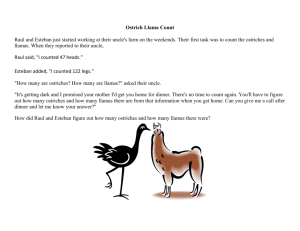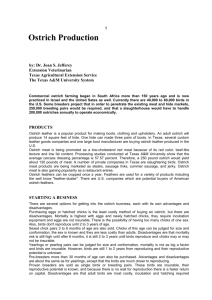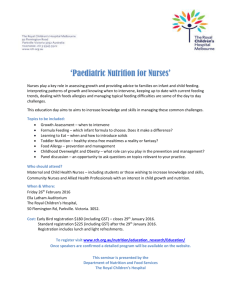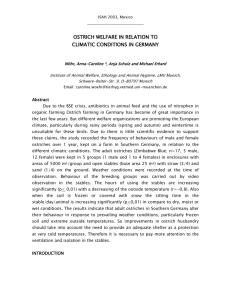NUTRITION
advertisement
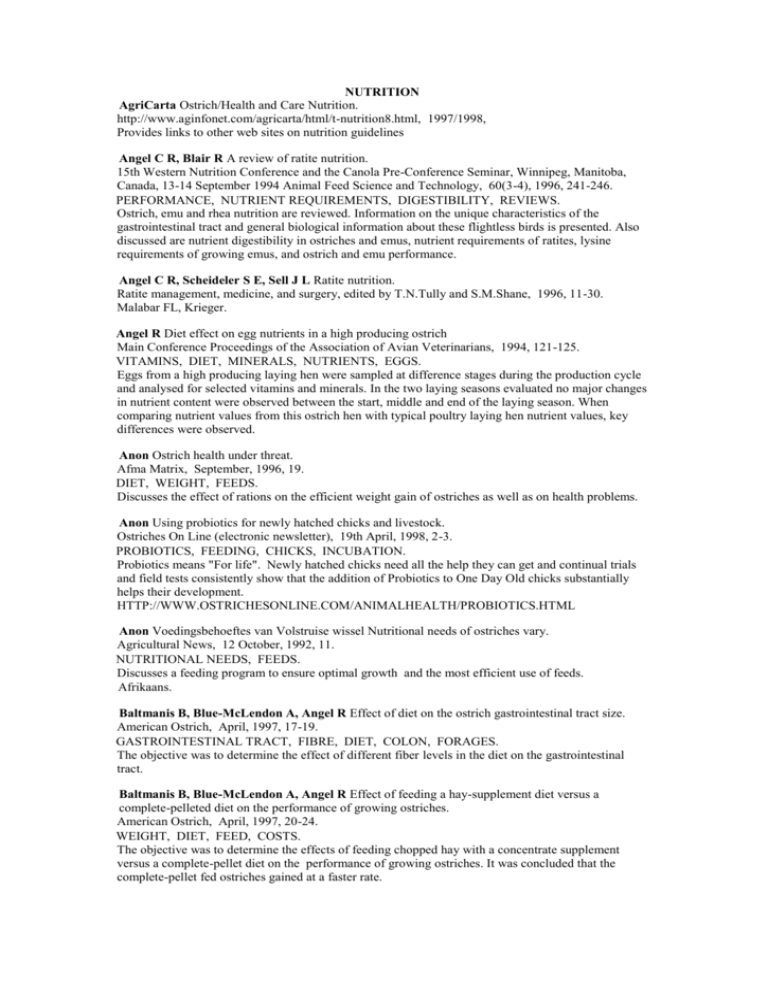
NUTRITION AgriCarta Ostrich/Health and Care Nutrition. http://www.aginfonet.com/agricarta/html/t-nutrition8.html, 1997/1998, Provides links to other web sites on nutrition guidelines Angel C R, Blair R A review of ratite nutrition. 15th Western Nutrition Conference and the Canola Pre-Conference Seminar, Winnipeg, Manitoba, Canada, 13-14 September 1994 Animal Feed Science and Technology, 60(3-4), 1996, 241-246. PERFORMANCE, NUTRIENT REQUIREMENTS, DIGESTIBILITY, REVIEWS. Ostrich, emu and rhea nutrition are reviewed. Information on the unique characteristics of the gastrointestinal tract and general biological information about these flightless birds is presented. Also discussed are nutrient digestibility in ostriches and emus, nutrient requirements of ratites, lysine requirements of growing emus, and ostrich and emu performance. Angel C R, Scheideler S E, Sell J L Ratite nutrition. Ratite management, medicine, and surgery, edited by T.N.Tully and S.M.Shane, 1996, 11-30. Malabar FL, Krieger. Angel R Diet effect on egg nutrients in a high producing ostrich Main Conference Proceedings of the Association of Avian Veterinarians, 1994, 121-125. VITAMINS, DIET, MINERALS, NUTRIENTS, EGGS. Eggs from a high producing laying hen were sampled at difference stages during the production cycle and analysed for selected vitamins and minerals. In the two laying seasons evaluated no major changes in nutrient content were observed between the start, middle and end of the laying season. When comparing nutrient values from this ostrich hen with typical poultry laying hen nutrient values, key differences were observed. Anon Ostrich health under threat. Afma Matrix, September, 1996, 19. DIET, WEIGHT, FEEDS. Discusses the effect of rations on the efficient weight gain of ostriches as well as on health problems. Anon Using probiotics for newly hatched chicks and livestock. Ostriches On Line (electronic newsletter), 19th April, 1998, 2-3. PROBIOTICS, FEEDING, CHICKS, INCUBATION. Probiotics means "For life". Newly hatched chicks need all the help they can get and continual trials and field tests consistently show that the addition of Probiotics to One Day Old chicks substantially helps their development. HTTP://WWW.OSTRICHESONLINE.COM/ANIMALHEALTH/PROBIOTICS.HTML Anon Voedingsbehoeftes van Volstruise wissel Nutritional needs of ostriches vary. Agricultural News, 12 October, 1992, 11. NUTRITIONAL NEEDS, FEEDS. Discusses a feeding program to ensure optimal growth and the most efficient use of feeds. Afrikaans. Baltmanis B, Blue-McLendon A, Angel R Effect of diet on the ostrich gastrointestinal tract size. American Ostrich, April, 1997, 17-19. GASTROINTESTINAL TRACT, FIBRE, DIET, COLON, FORAGES. The objective was to determine the effect of different fiber levels in the diet on the gastrointestinal tract. Baltmanis B, Blue-McLendon A, Angel R Effect of feeding a hay-supplement diet versus a complete-pelleted diet on the performance of growing ostriches. American Ostrich, April, 1997, 20-24. WEIGHT, DIET, FEED, COSTS. The objective was to determine the effects of feeding chopped hay with a concentrate supplement versus a complete-pellet diet on the performance of growing ostriches. It was concluded that the complete-pellet fed ostriches gained at a faster rate. Benson F (Nutrition). Ostrich@ostfeed.com, 1 July, 1998, 2pp. LISTSERVS, FEEDS. Fiona Benson recommends that processors and farmers cooperate as that will help the processors to improve the quality of carcasses they receive. This will help them to sell at good prices and in return reward the farmer better Benson F Ostrich feeding management. Ratite Nutrition Bulletin (electronic publication), 43, 1999, PRODUCTIVITY, FEEDING, ELECTRONIC NEWSLETTERS. Whether you have only a few birds or many thousands, the principals of good feed management remain the same. Benson F Southern States Feed. Ostrich@ostfeed.com, 12 March, 1997, 1p. FEEDS, LISTSERVS, MONENSIN. Fiona Benson warns farmers to be careful about feeds for ostriches as there can be additives that are fatal. Boyazoglu P A Ostrich nutrition for commercial production and wildlife nutrient supplements, IN: Animal nutrition; concepts and applications. 1997, 237-239. Pretoria, Van Schaik. FEEDS, NUTRIENT SUPPLEMENTS A table presenting ostrich feeding rates according to age is included in this discussion of the nutrition of ostriches kept in the veld or in camps. Brand T S, De Brabander L, Van Schalkwyk S J The true metabolisable energy content of canola oilcake meal and full-fat canola seed for ostriches (Struthio camelus). British Poultry Science, 41(2), 2000, 201-203. CANOLA, DIET. Burlini F Feeding of ostriches. ( L'alimentazione degli struzzi ).. Informatore Agrario, 55(42), 1999, 111-119. DIET, PRODUCTION, FEEDING, ECONOMICS, FEEDS, DIGESTIVE SYSTEM, MORTALITY. Ostrich feeding is discussed. Many ostrich farmers have incorrect information about the way to feed ostriches. Causes of this are: ignorance about the ostrich digestive system; and inaccurate information about some feeds. It is important to recognize a healthy chick and the effects of an unbalanced diet. Italian. Cilliers F Voeding van dagoud tot slag Feeding from day one to slaughter. Landbouweekblad, 9 February, 1996, 34-36. FEEDING. Feeding needs of the ostrich during the first 14 months.Research enables the farmer to feed the ostrich correctly as to obtain optimal growth and maximum economic benefit. Afrikaans. Cilliers S C, Hayes J P, Chwalibog A, Du Preez J J, Sales J A comparative study between mature ostriches (Struthio camelus) and adult cockerels with regard to the true and apparent digestibilities of amino acids.. British Poultry Science, 38(3), 1997, 311-313. AMINO ACIDS, DIGESTIBILITY, DIGESTION. Apparent and true digestibility of amino acids in a high-protein diet was compared in young ostriches (7 months of age) and cockerels. A mean value for true digestibility of amino acids of 0.837±0.0073 (0.780-0.862) was observed for ostriches, compared with a value of 0.795±0.0258 (0.723-0.825) for cockerels. True retention of dietary protein was 0.646±0.0114 and 0.609±0.0643 for ostriches and cockerels, respectively. The present study provides evidence that the method for estimating ME values of ingredients for ostriches is also suitable for measuring the digestibility of amino acids. It is concluded that accurate diet formulation for ostriches requires the assessment of amino acid digestibility for individual ingredients, because values derived from poultry would underestimate digestibility values for ostriches (Struthio camelus) and adult cockerels with respect to true and apparent metabolisable energy values for maize, barley, oats and triticale.. British Poultry Science, 38(1), 1997, 96-100. ENERGY, METABOLISM, FEEDS. Three successive trials with cockerels and mature ostrich males were performed to determine apparent and true ME values, corrected for nitrogen retention (AMEn and TMEn), using a balance method for malting barley, oats, triticale and yellow maize. All ingredients were used as sole dietary components with the exception of triticale for ostriches which was diluted with lucerne meal 440 g/kg. The balance trial lasted 5 days after an adaptation period of 7 days for ostriches, and 3 days after an adaptation period of 1 day for cockerels. AMEn values for cockerels of malting barley, oats, triticale and maize were 11.6, 10.48, 11.44 and 14.42 MJ/kg, respectively. Significantly higher values of 14.21, 12.65, 12.60 and 14.89 MJ/kg were determined for malting barley, oats, triticale and maize for ostriches. TMEn values determined by regression yielded values in ostriches of 13.92, 12.27, 13.21 and 15.22 MJ/kg for malting barley, oats, triticale and maize. The corresponding TMEn values in cockerels were 11.33, 10.63, 11.82 and 14.07 MJ/kg. The ostrich is capable of utilizing fibre more efficiently than poultry. The higher energy values observed for the various ingredients also indicated that the nonstarch polysaccharides such as beta-glucans and arabinoxylans in the more fibrous energy sources had little, if any, effect on the available energy of these ingredients in ostriches. The potential of ostriches to utilize the more fibrous energy sources like barley, oats and triticale allows for economical use in diet formulation. This may result in markedly lower feed costs for ostriches. Cilliers S C, Angel C R, Deeming D C Basic concepts and recent advances in digestion and nutrition.. Ostrich: biology, production and health, 1999, 105-128. Wallingford; UK, CABI Publishing. DIGESTION, DIGESTIVE TRACT, AGE, DIET, FEEDS, UREA. This chapter briefly describes reports of the diet of wild ostriches. The anatomy of the digestive tract and changes induced by age and diet are also discussed. Other sections include: feedstuff evaluation; amino acid metabolism; implications of urea contamination of ostrich diets; and practical feed-flow programmes. Cilliers S C, Sales J, Hayes J P, Chwalibog A, Du Preez J J Comparison of metabolisable energy values of different foodstuffs determined in ostriches and poultry. British Poultry Science, 40(4), 1999, 491-494. ENERGY VALUES, DIET, DIGESTION, MAIZE, FEEDS. 1. Apparent (AME(n)) and true (TMEn) metabolisable energy values, corrected for nitrogen retention, of wheat bran, saltbush (Atriplex nummularia), common reed (Phragmites australis), lupins, soyabean oil cake meal (SBOCM), sunflower oil cake meal (SFOCM) and fishmeal were compared in 7 successive trials using 12 mature South African Black ostriches and 10 adult Australorp cockerels per ingredient. 2. TRMEn values of 11.91, 7.09, 8.67, 14.61, 13.44, 10.79 ansi 15.13 MJ/kg for wheat bran, saltbush, common reed, lupins, SBOCM, SFOCM and fishmeal, respectively, were found for ostriches in comparison to lower (P<0.05) values of 8.55, 4.50, 2.79, 9.40, 9.04, 8.89 and 13.95 MJ/kg for cockerels. 3. The higher (P<0.05) ME values for ostriches confirm that the ostrich is capable of digesting foodstuffs, especially those with high fibre concentrations such as drought-resistant fodders, more effectively than poultry. Plant protein sources could make a considerable energy contribution to diets for ostriches. 4. It is concluded that it is essential to use energy values of foodstuffs determined using ostriches and not extrapolated values derived from poultry in diet formulation for ostriches. Cilliers S C, Hayes J P, Chwalibog A, Sales J, Du Preez J J Determination of energy, protein and amino acid requirements for maintenance and growth in ostriches. Animal Feed Science and Technology, 72(3-4), 1998, 283-293. NUTRIENT REQUIREMENTS, GROWTH, ENERGY, PROTEIN, AMINO ACIDS. Requirements for maintenance and the utilization of dietary true ME, corrected for N retention (TMEn), effective energy, corrected for N retention, protein and amino acids were assessed in 44 young ostriches (7 months of age) by means of a comparative slaughter technique. Response in nutrient gain (energy, lipid, protein and amino acids) in feathers, legs, hides and carcasses were separately studied by scarifying 8 birds at the beginning and 12 birds at the end of a 21-day feeding period. TMEn required for maintenance was 0.425 MJ/kg0.75 empty body weight (EBW) daily or 7.96 MJ/day, while maintenance requirements for effective energy, corrected for N retention, amounted to 0.311 MJ/kg0.75 EBW daily or 8.90 MJ/day. Utilization efficiencies for TMEn were estimated as 0.414±0.006 (MJ/kg0.75 EBW daily) and 0.443±0.016 (MJ/day), whereas a value of 0.568±0.009 was determined for effective energy, corrected for N retention. Digestible maintenance protein requirements of 0.678±0.027 g/kg0.75 EBW daily were found, and by altering this estimate to requirement for total dietary protein, 1.05±0.038 g/kg0.75 EBW daily was calculated. Maintenance requirements for lysine, methionine + cystine, threonine and valine compared favourably with literature values for poultry, but substantially higher values than for poultry were determined for leucine, arginine and histidine. Net utilization estimates for digestible amino acids varied between 0.948±0.025 for the slow-turnover amino acids (arginine) and 0.569±0.015 for the fast-turnover amino acids (cystine) with a mean value of 0.747. Cilliers S C Evaluation of foodstuffs and the metabolisable energy and amino acid requirements for maintenance and growth in ostriches (Struthio camelus). Thesis PhD(Agric) University of Stellenbosch.. 1995, 15 chapters. Stellenbosch, University of Stellenbosch. GROWTH, FEED UTILISATION EFFICIENCY, FEEDS, AMINO ACIDS, ENERGY. Cilliers S C Feedstuff evaluation, metabolisable energy and amino acid requirements for maintenance and growth in ostriches.. Proceedings of the Second International Scientific Ratite Congress, Oudtshoorn, South Africa, 21-25 September 1998., 1998, 12-23. Oudtshoorn, NUTRIENT REQUIREMENTS, AMINO ACIDS, ENERGY, GROWTH, METABOLISM, FEEDS. There is a growing interest world wide in ostrich farming and although it is a well-established industry in South Africa, knowledge on various nutritional aspects is not well defined. Commercial farming of ostriches requires an accurate evaluation and knowledge of the nutrient contents of ingredients available for formulating diets. The recent announcement of reduced income, due to a higher supply, underlines the need for scientific feeding to ensure profitable production. To satisfy these requirements, accurate knowledge of nutrition needs is necessary for various stages of growth and production. Nitrogen corrected true metabolisable energy (TMEn) values of various ingredients were determined by the balance method. Comparative studies between ostriches and roosters emphasise the unique digestibility characteristics of ostriches, thus indicating the essentiality for an ostrich series of nutritional values. A model between TMEn for ostriches and poultry was derived from these studies that could serve as a quick reference and aid in routine analysis of foodstuffs. Requirements for maintenance, utilisation of dietary amino acids, TMEn and effective energy were determined by a comparative slaughter technique. This information was used to estimate requirements for ostriches in various growth stages according to the Gompertz curve. Results obtained enabled the establishment of nutrient requirement guidelines for ostriches. TMEn values and amino acid digestibility figures can now assist the ostrich nutritionist to scientifically and economically formulate diets according to stage of growth and production. Cilliers S C, Hayes J P, Sales J, Chwalibog A, Du Preez J J Research note: a comparison of metabolisable energy values of lucerne and barley between young and mature ostriches. Archives of Animal Nutrition, 51(1), 1998, 77-82. AGE, DIET, ENERGY VALUES, FEEDS, LUCERNE. Apparent (A) and true (T) ME values, corrected for zero N retention (MEN), of cold-pelleted lucerne (Medicago sativa) and barley (Hordeum vulgare) were compared in balance studies between 24 sixmonth-old male ostriches and 24 mature male ostriches (30 months old). Feed input and excreta output were measured over 5 days after an adaptation period of 7 days on experimental diets. AMEN of 9.17±0.251 (lucerne) and 14.24±0.136 MJ/kg (barley) did not differ significantly from values obtained for mature ostriches (8.97±0.226 and 14.21±0.134 MJ/kg, respectively). No significant differences were found for TMEN for young ostriches (9.16±0.450 and 13.94±0.390 MJ/kg, respectively) and mature ostriches (9.26±0.412 and 13.92±0.316 MJ/kg, respectively). It is concluded that similar AMEN and TMEN values of feedstuffs would be suitable in ostrich diets for age groups older than 6 months. Cilliers S C, Hayes J P, Sales J, Chwalibog A, Du Preez J J The additivity of TMEn values of various ingredients in a complete diet for ostriches and adult roosters. Animal Feed Science and Technology, 71(3-4), 1998, 369-373. ENERGY VALUES, DIET, FEEDS. The additivity and accuracy of true ME values, corrected for N retention (TMEn), of different diet ingredients previously determined for ostriches, were evaluated by feeding a diet containing a number of these ingredients to ostriches and roosters. The TMEn value of the test diet was determined with 36 young ostriches (7 months old) by a balance method of continuous feeding for 5 days after an adaption period of 7 days. The diet was also offered for 3 days to 10 adult roosters after an adaption period of 24 h. Theoretical values of 11.69±0.189 MJ/kg and 8.28±0.181 MJ/kg calculated for the test diet for ostriches and roosters, respectively, compared well with determined values of 11.25±0.072 MJ/kg and 8.02±0.445 MJ/kg, respectively. It is concluded that reliable energy values are now available for the establishment of energy requirements and diet formulations for ostriches. Coetsee J Jongste riglyne vir volstruisvoeding. Landbouweekblad, 18 Feb, 2000, 38-44. KLEIN KAROO COOPERATIVE, FEEDING, RESEARCH. Reports on the latest experiments that have been done by the Klein Karoo Agricultural Co-operative near Oudtshoorn on the feeding of ostriches. An expert gives directives on feeding as well as an overview on the latest research on the feeding of ostriches. Afrikaans. Coetsee J Prikkelvoeding is maklik met regte riglyne Stimulation feeding - guide lines. Landbouweekblad, 16 June, 2000, 34, 35, 37. FEEDING, BREEDING. After the resting period farmers must take care in stimulating mating, breeding and egg production, to ensure a good breeding period. Tables listing rations are given. Afrikaans. Coetsee J Red Volstruis-"oes" met rustyd voeding Feeding during resting period. Landbouweekblad, 5 May, 2000, 26-29. PRODUCTION, FEEDING, RESTING PERIOD. First to third month of resting period nutrition and handling Afrikaans. Coetsee J Regte rantsoen verseker geil kuikenoes (Correct feeding rations will ensure successful chick breeding). Landbouweekblad, 11 August, 2000, 34-36. CHICKS, FEEDING. For effective chick production the correct feeds for breeding ostriches should be used. Dr Fanus Cilliers, manager of Camelus Feeds in Oudtshoorn gives advice. Cooper S M, Palmer T Observations on the dietary choice of free-ranging juvenile ostriches. Ostrich, 65(3-4), 1994, 251-255. BEHAVIOUR, DIET, PLANTS, KENYA. Innate preference for selected plant species by free ranging juveniles. Damsgaard E (Animal weed control in Norway spruce). Animalsk ukrudtsbekaempelse i nordmannsgranner. Landbonyt Erhvervsjordbruget, 4(9), 1997, 28-29. WEED CONTROL, DIET, GRAZING, DENMARK. With special reference to the prospects for application in Denmark, the control of weeds in Norway spruce plantations [Picea abies] using herbivorous animals (including ostriches, sheep and pigs) is discussed. Danish. Davis H J, Lambrechts H, Ganzevoort B, Cloete S W P, King P R, Davis W H, Blum R, Mienie L J The influence of a L-carnitine-magnesium supplement on the egg production and fertility of adult breeding ostriches.. Proceedings of the Second International Scientific Ratite Congress, Oudtshoorn, South Africa, 21-25 September 1998., 1998, 68-71. FERTILITY, MAGNESIUM, SUPPLEMENTS, EGGS, ENERGY, METABOLISM, HATCHABILITY, HORMONES. Farzi F E Comparison of two feeding practices for ostrich chicks.. Ostrich News Annual, 6, 1993, 153-154. CHICKS, FEEDING. It has been assumed that ostrich chicks are ready to start eating as soon as they are capable of walking and running around. Practically speaking, this theory has reached a point where it is believed that food must be offered to the baby chicks ad libium (as much as the chick can take). Hicks-Alldredge K Nutrition. Proceedings of the North American Veterinary Conference, 10, 1996, 808. Holle D The dilution factor - part 2 (Ratite feeding). Ostriches On Line (www.ostrichesonline.com), 20 April, 1998, 3-6. ELECTRONIC NEWSLETTERS, FEEDING. Daryl Holle is a ratite nutrition consultant for Blue Mountain Feeds, Inc. He discusses the effect of the Dilution Factor as it relates to protein, fat, fibre and energy nutrients in the ostrich diet. Horbanczuk J (Selected aspects of feeding ostriches under farming conditions) Wybrane aspekty zywienia strusi w warunkach fermowych. Biuletyn Informacyjny Instytut Zootechniki, 34(1), 1996, 27-36. DIGESTION, NUTRIENT REQUIREMENTS, FEEDING, REVIEWS. Nutrient requirements of ostriches are reviewed. Recommended requirements for ME, CP, crude fibre, lysine, methionine, threonine, tryptophan, isoleucine, arginine, minerals and vitamins are given in 2 tables. Adult ostriches can digest over 60% of NDF eaten, a value approaching that for ruminants. Growing ostriches can obtain up to 75% of their ME requirements by degrading cellulose. Polish Jamroz D Feeding ostriches and emus: Physiological basis and nutritional requirements: a review. Prace i Materialy Zootechniczne, 56, 2000, 51-73. ENERGY REQUIREMENTS, NUTRITIONAL REQUIREMENTS. This paper is a review of literature in the field of nutrition of ostriches and emus - the biggest herbivorous birds in the world. The keeping and breeding of these birds develops dynamically not only in South Africa, Australia, Israel, Canada and United States, but also in many European countries, including Poland. Essential information is presented relative to the specificity of the digestive tract, digestibility and requirements for nutrients and energy depending on the age and performance of birds. Also, principles are described of the practical feeding of ostriches and emus as well as the basal characteristic of ostrich egg and meat composition. Polish. Janssens G P J, Seynaeve M, De Wilde R O, De Rycke H (Nutritional aspects of the ostrich (Struthio camelus)). Voedingsaspecten van de struisvogel (Struthio camelus). Vlaams Diergeneeskundig Tijdschrift, 66(4), 1997, 153-160. VITAMINS, MINERALS, PROTEINS, DIGESTION, NUTRIENT REQUIREMENTS. The importance of protein, mineral, vitamin and other nutrient requirements in ostriches, is reviewed, along with behavioural peculiarities. These vary in accordance with the physiological status with respect to maintenance, growth and breeding. Dutch. Lambiase M, Di Meo C, Mauro P, Menna L F, Nizza A (Use of probiotics in ostrich nutrition. Preliminary note: digestive utilization in young animals). Impiego di probiotici nell'alimentazione dello struzzo. Nota preliminare: utilizzazione digestiva in giovani soggetti.. Nuovi aspetti della profilassi vaccinale in avicoltura. XXXVI Convegno della Societa Italiana di Patalogia Aviares, Forli, 25-26 September 1997 Selezione Veterinaria, 8-9, 1998, 661-665. DIGESTIBILITY, PROBIOTICS, SUPPLEMENTS, FEED ADDITIVES. Twelve ostriches, 6 weeks old, were divided into 3 groups; one group served as the control while the other 2 were supplemented with 1% Turval 6 and Turval 12 (2 different probiotics). Probiotic supplementation improved the digestibility of the ostriches. Italian Lambrechts H, Cloete S W P, Davis H J The influence of a L-carnitine-magnesium supplement on the behaviour of adult breeding ostriches. Proceedings of the Second International Scientific Ratite Congress, Oudtshoorn, South Africa, 21-25 September 1998, 1998, 170-172. CARNITINE, MAGNESIUM, SUPPLEMENTS, BEHAVIOUR, REPRODUCTION. L-carnitine plays a fundamental role in cellular metabolism and particularly in the utilization of lipid substrates. Lee J, Masters D G, White C L, Grace N D, Judson G J Current issues in trace element nutrition of grazing livestock in Australia and New Zealand. Australian Journal of Agricultural Research, 50(8), 1999, 1341-1364. GRAZING, REVIEWS, TRACE ELEMENTS, AUSTRALIA, NEW ZEALAND, DIET, LIVER DISEASES, SELENIUM, STRESS, FEEDING, SUPPLEMENTS, TOXICITY, ZINC. This review focuses on research over the past 10 years, addressing issues and perspectives on the roles, risks of inadequacy, and supplementary remedies of key trace elements, both essential and deleterious, which have an impact on the productivity and product quality of grazing livestock throughout Australia and New Zealand. The emphasis is on Cu, Co, I, Se and, to a lesser extent, Zn - the trace elements most frequently found to be deficient in parts of Australia and New Zealand. Research continues to elucidate new roles for trace elements in the animal, and as this leads to a better understanding of requirements, diagnostic criteria and supplementation strategies need re-evaluation. Newer perspectives on marginal deficiency for Cu, I, Se, and Zn are given and issues for risk management discussed. Advances in sustained delivery of trace elements such as Co (as vitamin B12), I, and Se are reported. The diagnosis and management of marginal Cu deficiency continue to be difficult, especially in New Zealand where recent work has shown that dietary antagonists (Fe, Mo, and S) may impair Cu absorption at lower intakes than previously thought. There is still a dearth of scientific data on the advantages of using socalled organic trace element supplements (metals complexed or chelated with amino acids or peptides). Nevertheless their usage continues to increase. There is increasing evidence that trace elements influence the pathophysiology arising from the ingestion of toxins. This review summarizes recent work on the role of Co in annual ryegrass toxicity; Cu, Se, and Zn in lupinosis; Cu and alkaloid toxicity; Zn and facial eczema; and Co and white liver disease. Trace elements are required to support immune function (e.g. as imposed parasite infection) and marginal deficiencies may be exacerbated by an immunological challenge. The roles of Cu, Co, Mo, Se, and, to a lesser extent, Cr and Zn have attracted attention and under conditions of stress there may be an additional need for these elements. Diversification in farming has led to the introduction of species such as deer (Cervus), alpacas (Camelids), emus, and ostriches (Ratites) and the paucity of information on trace element requirements for these species, and also for horses, indicates the need for further work. The effect of supplementation on trace element composition of meat, milk, and wool is also reviewed, both in terms of product characteristics and human health. Of the deleterious elements, Cd has attracted the most interest and concern because of its introduction into the pastoral system from phosphate-based fertilizers. Leeson S, Summers J D Commercial poultry nutrition. 1991, 276-277. Guelph, University Books. DIET. With increased interest in the farming of ostriches for meat ,skin and feathers nutritionists are being asked to formulate diets for this species.Adult breeding ostriches may stand 2.5m high and weigh 100200kg producing up to 60 eggs each season.Although hatchability can be quite high,chick mortality is a major problem. Lochner H Alternatiewe beperk voerkoste (Alternative feeds reduce cost). Landbouweekblad, 10 April, 1998, 10-13. PASTURES, GRAINS, FEEDS, SILAGE. Production cost cut by utilising other means of nutrition. Afrikaans. Mannion P F, Kent P B, Barram K M, Trappett P C, Blight G W, Sales J Lysine requirements of growing emus. British Poultry Science, 40(2), 1999, 309-311. LYSINE, AMINO ACIDS, GROWTH, EMU, NUTRIENT REQUIREMENTS. The lysine requirement of growing emus between 23 and 65 days of age was determined according to growth response variables. The optimal lysine requirement was found to be 0.83 and 0.90 g/MJ ME for growth rate and gain:feed ratio, respectively. These findings are in accordance with the recommended value of 0.80 g/MJ ME, but is lower than the recommended value for ostriches (1.02 g/MJ ME) and higher than determined values for broilers (0.75 g/MJ ME) of the same age range. Milton S J, Dean W R J, Siegfried W R Food selection by ostrich in southern Africa. Journal of Wildlife Management, 58(2), 1994, 234-249. DIET, FEEDING Milton S J, Adams N J, Dean W R J, Du Plessis M A, Jackson S, Siegfried W R, Williams J R Foraging and food of free-range ostriches; implications for rangeland management. Abstracts of Meeting Rangeland Challenges in southern Africa in the 1990's. CSIR, Pretoria, Paper 70, 1991, Pretoria, Grassland Society of southern Africa. FORAGES, DIET, FEEDING. Reiner G So futtern Sie richtig (Correct feeding). DGS Magazin, 9, 1995, 51-53. FEATHER PICKING. German. Sales J, Du Preez J J Determination of the growth and nutrient requirements of ratites. Ostrich News, August 1995, 52-54, 82-87. MATURITY, GROWTH, SLAUGHTER, MEAT, NUTRIENT REQUIREMENTS. With the widespread decline in the available funding for research, a more efficient approach to determine nutrient requirements must be devised. Salih M E, Brand T S, Van Schalkwyk S J, Blood J, Pfister B, Brand Z, Akbay R The effect of dietary fibre level on the production of growing ostriches. Proceedings of the Second International Scientific Ratite Congress, Oudtshoorn, South Africa, 21-25 September 1998, 1998, 31-37. FIBRE, DIET, DIGESTIVE TRACT, CELLULOSE, FEEDS. This paper presents data demonstrating that the ostrich hind gut is capable of digesting and utilising high fibre diets. Scheideler S, Angel R Feeding big birds. Large Animal Veterinarian, 49 (2), 1994, 28-30. DIGESTION, NUTRIENTS, DIGESTIVE SYSTEM. In contrast to other types of poultry, ratites do not have a crop. Ratites are capable of fermentation making their digestive system similar to that of the ruminant. Scheideler S E, Kunze K Effects of the mycotoxins vomitoxin and aflatoxin B1 on ostrich growth parameters. Proceedings of the Second International Scientific Ratite Congress, Oudtshoorn, South Africa, 21-25 September 1998, 1998, 46-49. Oudtshoorn, GROWTH, DIET, MYCOTOXINS, VOMITOXIN, AFLATOXINS, FEEDS, TOXICITY, WHEAT. The effects of dietary vomitoxin intake from naturally contaminated wheat midds on feed consumption, growth and feed conversion efficiency were examined and the toxicity of oral aflatoxin B1 to young ostrich chicks was determined. It was concluded that ratite diets containing wheat midds naturally contaminated with less than 2 mg/kg vomitoxin could cause early depression of feed intake and some decrease in growth rate without any signs of morbidity. Scheidler S E Nutrition and physiology of ratites. Proceedings of the 18th Annual Conference on Avian Medicine and Surgery: Mid-Atlandic States Association of Avian Veterinarians, Clinton, MD, USA, 1997, 1997, 149-155. PHYSIOLOGY, STOMACH MOTILITY. Siegfried W R, Milton S J, Dean W R J Stocking rates for ostriches; some consequences of confining desert nomads. Abstracts of the 3rd International Wildlife Ranching Symposium. CSIR, Pretoria, Paper 2A.4, 1992, South African Agricultural Union South African Wildlife Management Association. ECOLOGY, DIET, FEEDING Ullrey D E, Allen M E Nutrition and feeding of ostriches. N. American Nutrition Conferences III Animal Feed Science and Technology, 59(1-3), 1996, 27-36. NUTRIENT REQUIREMENTS, FEEDING, GROWTH, WEIGHT, EGG PRODUCTION, CALCIUM, REVIEWS. The historic habitat, environmental adaptability, feeding behaviour in the wild, breeding behaviour in the wild, gastrointestinal anatomy and function, nutrient requirements and feeding suggestions for ostriches are discussed. Very few experiments have been conducted to determine nutritional requirements of ostriches and it was suggested that the turkey is the best avian model from which to predict ostrich nutrient needs. It was concluded that to minimize leg abnormalities in ostrich chicks, it may be helpful to restrict liveweight gain by limiting dietary protein concentrations below those recommended for starting turkeys and by feeding high-fibre diets. Non-slip surfaces and exercise are also very important. Egg production by ostriches laying a normal annual clutch does not significantly increase the dietary calcium requirement; however, when egg production is forced by continually removing eggs, increased Ca requirements should be met by providing dietary concentrations of 16 g/kg or by ad libitum access to granulated calcium carbonate or oyster shell. Van Niekerk B D H European forages in ostrich production. Proceedings of the annual meeting of the European Ostrich Association, World Congress November 1996, Hengelo, The Netherlands, 1996, 1-5. FORAGES, DIET. The ostrich as a producer of meat, skin and feathers, has a number of important advantages over other avian species. One of these advantages is its ability to make extensive use of forages for maintenance and production purposes. Tables listing TME values of various feedstuffs for ostriches are included. Van Niekerk B D H The science and practice of ostrich nutrition. Journal of the Zimbabwe Society for Animal Production, 7, 1995, 45-60. DIET, PRODUCTION, FEEDING, NUTRIENT REQUIREMENTS, REVIEWS. Nutritional requirements of ostriches and recommendations for the formulation of complete ostrich diets are reviewed. Van Niekerk B D H Voeding van volstruise onder intensiewe toestande Feeding of ostriches under intensive conditions. Afma Matrix, 19 September, 1995?, 11, 13. FEEDING. Interest in ostrich farming has grown considerably in recent years, but information on ostrich feeding is hard to come by. Viljoen B Feed well for successful breeding. Farmer's Weekly, 19 January, 1996, 10-12. BREEDING, FEEDING, RESTING PERIOD. Gives advice on correct feeding of ostriches during the rest and laying periods. Describes free feeding systems and restricted feeding systems and the uses of both. Photographs included Warrington S Ostrich nutrition and feed index. www.achiever.com/feed/feedindex.html, 2000?, 4pp. Ostriches On Line. FEEDS, UNITED STATES. Good nutrition is the correct path to profitability. This article discusses production targets to attain maximum profitability and efficiency. Blue Mountain ostrich feed products are described. Zhang G Y, Wang S J, Cui G Y Studies on the nutrition and feeding of ostrich. Chinese Journal of Zoology, 31(6), 1996, 40-43. FEEDING, DIET, MINERALS, NUTRIENT REQUIREMENTS. Chines


